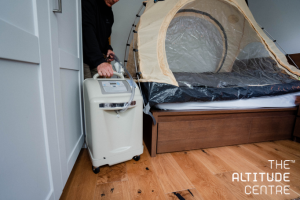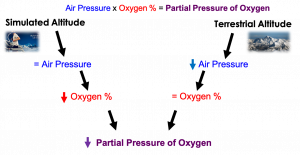By now, we’ve seen really good evidence of the benefits of altitude training. Whether looking to improve performance in cycling, running or team sports, training for your next mountain summit (or your first!) or even looking to improve your general health and wellbeing, we know that altitude training can be of huge benefit.
But have you ever considered what altitude training actually is? For example, what is altitude? How do we recreate altitude in the heart of London, or in the comfort of your own home? And what’s the point? Well, wonder no more…

What Is Altitude?
If you ask 100 people what altitude is, you might get 100 different answers. Ask someone in Holland, one of the flattest countries on Earth, and they might consider a hill of just a few hundred metres to be altitude. Ask their Nepali counterpart however, and the answer may well be in the thousands of metres. For them, it’s about perspective.What Is Altitude?
Fortunately, researchers have classified altitude as near sea level (<500 m), low (500-2000 m), moderate (2000-3000 m), high (3000-6000 m) and severe or extreme (6000+). The low and moderate altitude bands are those in which you are likely to do the majority of altitude training. Once you move into the high altitude band, things become tougher on the body, and this is where most popular trekking peaks like Kilimanjaro, and alpine climbs like Mt Blanc sit. The severe altitude band presents an extreme challenge to the body; a level to which extended exposure leads to deterioration of the human condition. For reference, the summit of Everest sits at 8849 m.
The key when it comes to altitude training, isn’t the altitude itself. The body doesn’t have an internal altimeter that ticks round and recognises when you’re at moderate or high altitude. Rather, it senses a reduced availability of oxygen; what we call hypoxia (literally meaning low oxygen). At high altitude, the concentration of oxygen in the air remains at 20.9% up to around 29000 m, but the higher you climb, the thinner the air becomes as the barometric pressure reduces. This means that the partial pressure of oxygen is reduced, and that is what the body sees. You can think of the partial pressure as the availability of oxygen, and it is given by the equation:
Partial Pressure of Oxygen = Barometric Pressure x Oxygen Concentration
So as altitude increases, although oxygen concentration remains constant, the reduced barometric pressure results in a reduced oxygen availability. Because the hypoxia is caused by low barometric pressure, we call this hypobaric hypoxia, meaning low pressure, low oxygen.
But What About Simulated Altitude?

The partial pressure equation shows us that oxygen availability can be influenced by both barometric pressure and oxygen concentration. While it is possible to create hypobaric chambers by reducing barometric pressure, it is far more straightforward to reduce oxygen content to influence partial pressure. The technology we use at The Altitude Centre works on oxygen filtration, which means our hypoxic generators draw normal air in and removes someof the oxygen from it, before feeding it through tubing into a mask for exercise or intermittent hypoxic exposure or a tent for sleep. Our landmark chamber in London simply works on a large scale version of the same principle, providing enough hypoxic air to fill our altitude chamber and allow up to 12 people to exercise at the same time. Because this type of hypoxia is created without changing barometric pressure, it is called normobaric hypoxia (normal pressure, low oxygen).

What Happens To The Body?
It’s clear that reducing the availability of oxygen in the air, reduces the amount of oxygen available to the body. We use finger pulse-oximeters to measure the amount of oxygen in your blood (known as spO2).

At sea level, this is usually above 95% at rest in healthy people, and maintained above 90% even during intense exercise. At moderate altitude this may drop into the mid 80’s during exercise, and high or severe altitudes could cause huge drops into the 70’s and beyond if not controlled. This triggers a series of changes in the body which contribute to improved fitness, acclimation, and overall health and wellbeing. The good news is that the effect of hypoxia seems to be the same whether normobaric or hypobaric, meaning that you truly can gain the same benefits at home or in our hypoxic chamber as you would get on the mountain!
Is It For Me?
In short, yes. The research demonstrates that hypoxic training is not just the reserve of elite athletes and high altitude mountaineers. We are seeing more and more people looking to altitude training for a more time effective workout, improved performance, and better health and wellbeing. Now, you can make the most of hypoxic technology by training at our London centre, or in the comfort of your own home with one of our rentals systems. You don’t even need to exercise to get the benefits! Feel free to get in touch with our team of Performance Specialists to find out how hypoxic training can fit into your training.
